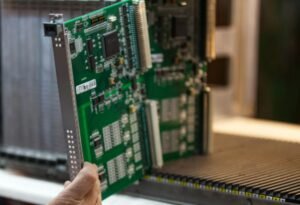Generative Music Effects
Introduction
Generative music effects are a fascinating aspect of music production that introduce randomness and unpredictability into a musical composition. By utilizing algorithms and computer programming techniques, composers can create dynamic and ever-changing soundscapes. This article explores the concept of generative music effects, their key components, and their impact on the creative process.
Key Takeaways
- Generative music effects introduce randomness and unpredictability into compositions.
- Algorithms and programming techniques are used to create dynamic soundscapes.
- Generative music effects enhance creativity and offer unique listening experiences.
Understanding Generative Music Effects
Generative music effects involve the use of algorithms to drive the composition process, allowing for variations and exploration of musical ideas. These effects can be applied to various aspects of music production, including melody, harmony, rhythm, and sound design. *Generative music effects provide a fresh and innovative approach to music creation, enabling composers to break away from traditional structures and embrace new sonic possibilities.*
Benefits of Generative Music Effects
Generative music effects offer several advantages to composers and listeners alike. Firstly, they provide a means to overcome creative blocks by introducing unexpected elements into the composition process. Additionally, they allow for endless variations and permutations, promoting exploration and experimentation. *The dynamic nature of generative music effects keeps compositions alive and ever-evolving, captivating listeners across multiple listens.*
- Overcome creative blocks.
- Promote exploration and experimentation.
- Captivate listeners with dynamic compositions.
Components of Generative Music Effects
Generative music effects comprise several components that work together to create unique musical experiences. These components include:
- Generative Algorithms: Algorithms that generate musical events based on predefined rules and variables.
- Parameter Automation: Automation of musical parameters over time, allowing for evolving textures and melodies.
- Randomization: Introduction of randomness to create unpredictable elements within the composition.
- Sequencers: Tools that create and manipulate sequences of musical events.
| Software | Description |
|---|---|
| Max/MSP | An open-ended graphical programming environment for music, audio, and multimedia. |
| Kyma | A sound design environment with powerful generative and interactive capabilities. |
| SuperCollider | A platform for audio synthesis and algorithmic composition. |
Exploring Musical Possibilities
Generative music effects offer composers a vast array of possibilities for musical exploration. They allow for the discovery of new chord progressions, unusual melodic patterns, and unexpected harmonies. *By embracing generative music effects, composers can push the boundaries of their creativity and unveil musical ideas they may have never imagined.*
| Technique | Description | Advantages |
|---|---|---|
| Markov Chains | Modeling music through the use of probabilistic transitions between musical events. |
|
| Cellular Automata | Creating music by defining musical rules based on the behavior of cells in a grid. |
|
| Neural Networks | Using machine learning techniques to train algorithms on existing music and generate new compositions. |
|
Enhancing the Listening Experience
Generative music effects transform the listening experience by offering unique and captivating sonic journeys. Unlike traditional compositions, generative music keeps evolving and surprising listeners, creating a sense of exploration and discovery. *This interactive aspect of generative music effects invites active engagement and enables the creation of personalized musical experiences.*
Incorporating Generative Music Effects
Generative music effects can be incorporated into compositions in various ways. Composers can use standalone software or plugins specifically designed for generative music, or they can implement their own algorithms within digital audio workstations (DAWs). With experimentation and practice, composers can seamlessly blend generative and traditional compositional techniques to create captivating musical works.
Embrace the Ever-Evolving Nature of Music
Generative music effects offer composers and listeners a fresh perspective on the creative process. By harnessing the power of algorithms and randomness, composers can unlock new musical possibilities and create dynamic, ever-changing compositions that captivate audiences. So why not embrace the exciting world of generative music effects and embark on a journey of endless musical exploration?

Common Misconceptions
Misconception #1: Generative music is just random noise
One common misconception about generative music is that it is just random noise with no structure or purpose. However, generative music is actually carefully composed and created using algorithms and rules to generate unique musical patterns and sequences. It is a creative process that allows for endless variations and possibilities.
- Generative music is thoughtfully composed using algorithms and rules.
- It is not random noise but rather structured and purposeful.
- Endless variations and possibilities can be achieved through generative music.
Misconception #2: Generative music is created by robots
Another misconception is that generative music is solely created by robots or AI systems. While it is true that technology plays a significant role in the creation of generative music, human composers and musicians are still deeply involved in the creative process. They design the algorithms, set the rules, and make artistic decisions to shape the music created.
- Technology is used in the creation of generative music, but humans are still involved.
- Human composers design the algorithms and set the rules.
- Artistic decisions are made by humans to shape the generative music.
Misconception #3: Generative music lacks emotional depth
Some people believe that generative music lacks emotional depth because it is created through algorithms and rules. However, generative music has the potential to evoke deep emotions and create meaningful experiences for listeners. The rules and algorithms can be designed to incorporate musical techniques and elements that convey specific moods and emotions.
- Generative music has the potential to evoke deep emotions in listeners.
- The rules and algorithms can be designed to convey specific moods and emotions.
- Meaningful experiences can be created through generative music.
Misconception #4: Generative music is always ambient or background music
Many people associate generative music with ambient or background music, assuming it is always meant to serve as a subtle backdrop. Although generative music is often used in ambient or meditative contexts, it can also be designed for active listening and be the main focus of a musical experience. Generative music can be diverse in style and genre, ranging from experimental compositions to melodic tunes.
- Generative music can be designed for active listening.
- It is not limited to ambient or background music.
- Generative music can encompass various styles and genres.
Misconception #5: Generative music is impersonal and lacks creativity
Some people assume that generative music is impersonal and lacks the creativity and human touch found in traditional composition. However, generative music is a result of a collaboration between human creativity and technology. It is a tool that allows for new forms of artistic expression and exploration. The algorithms and rules provided by the composer act as a framework, while the generative process itself adds an element of unpredictability and surprise.
- Generative music is a collaboration between human creativity and technology.
- It is a tool for new forms of artistic expression and exploration.
- Generative music combines a framework with an element of unpredictability and surprise.

Introduction
In recent years, generative music has gained popularity in the music industry. This innovative approach to music composition involves using algorithms and technology to create music that evolves and changes over time. It not only offers musicians new creative possibilities but also provides unique listening experiences for the audience. In this article, we will explore the fascinating effects of generative music through a series of tables showcasing various aspects of this emerging field.
Table: Famous Artists Who Utilize Generative Music
Many accomplished musicians have embraced generative music as a tool for their artistic expression. The following table highlights some of the well-known artists who incorporate generative music techniques into their work.
| Artist | Genre | Notable Works |
|---|---|---|
| Brian Eno | Ambient | Ambient 1: Music for Airports |
| Aphex Twin | Electronic | Selected Ambient Works 85-92 |
| Hans Zimmer | Soundtrack | Interstellar – Original Motion Picture Soundtrack |
| Tim Hecker | Experimental | Ravedeath, 1972 |
Table: Advantages of Generative Music
Generative music offers numerous benefits to both musicians and listeners. The table below presents some of the advantages of this unique approach to music creation.
| Advantage | Description |
|---|---|
| Endless Variation | Generative music can create an infinite number of musical sequences, ensuring each listening experience is unique. |
| Enhanced Creativity | Artists can tap into generative music systems to inspire and explore new musical ideas they may not have discovered otherwise. |
| Immersive Listening | Generative music can captivate listeners by creating evolving soundscapes that transport them to different sonic realms. |
Table: Applications of Generative Music
The applications of generative music extend beyond traditional music production. The table below highlights various areas where generative music has found practical use.
| Application | Description |
|---|---|
| Ambient Background Music | Generative music is often used in public spaces, such as malls or museums, to provide a soothing and constantly evolving sonic backdrop. |
| Video Games | By adapting to the player’s actions, generative music in games enhances immersion and dynamic audio experiences. |
| Meditation and Mindfulness | Generative music can aid in relaxation and focus, creating an ideal sonic environment for meditation and mindfulness practices. |
Table: Notable Generative Music Systems
A variety of generative music systems have emerged, each offering unique features and capabilities. The following table showcases some notable generative music systems utilized by musicians and composers.
| System | Developer | Features |
|---|---|---|
| Koan | Timothy M. Thompson | Algorithmic music composition with customizable parameters. |
| Max/MSP | Cycling ’74 | A visual programming language for music and multimedia. |
| SuperCollider | James McCartney | An environment and programming language for real-time audio synthesis and algorithmic composition. |
Table: Generative Music vs. Traditional Composition
Comparing generative music with traditional composition methods reveals distinctive characteristics and approaches. The following table outlines some key differences between these two creative approaches.
| Aspect | Generative Music | Traditional Composition |
|---|---|---|
| Authorship | Shared between the composer and the generative system. | In the hands of the composer alone. |
| Repetition | Minimized or virtually non-existent due to algorithmic generation. | Often relies on repetition to establish motifs and musical structure. |
| Control | Artists relinquish a degree of control to the generative system, allowing for unpredictability. | Composers have complete control over every musical element. |
Table: Generative Music Software Comparison
A plethora of software tools is available to assist in generative music creation. The table below presents a comparison of some popular generative music software.
| Software | Platform | Price |
|---|---|---|
| Reaktor | Mac, Windows | $199 |
| Bitwig Studio | Mac, Windows, Linux | $399 |
| Max for Live | Mac, Windows | $199 |
Table: Generative Music in Films
The use of generative music in films has become increasingly prevalent among filmmakers seeking to create unique sonic experiences that complement visual storytelling. The table below showcases notable films that have incorporated generative music into their soundtracks.
| Film | Director | Composer |
|---|---|---|
| Inception | Christopher Nolan | Hans Zimmer |
| The Social Network | David Fincher | Trent Reznor, Atticus Ross |
| Arrival | Denis Villeneuve | Jóhann Jóhannsson |
Table: Generative Music and Emotional Impact
The ability of generative music to evoke emotional responses in listeners is a testament to its power and versatility. The following table highlights various emotions and the ways generative music can influence them.
| Emotion | Effect by Generative Music |
|---|---|
| Calmness | Soft, soothing textures and slow harmonic progressions create a calming atmosphere. |
| Euphoria | Complex, evolving musical patterns and uplifting melodies induce feelings of euphoria and joy. |
| Tension | Juxtaposition of dissonant elements, irregular rhythms, and abrupt changes can generate a sense of tension and suspense. |
Conclusion
Generative music presents a groundbreaking approach to music composition and listening experiences. Through its endless variation, immersive qualities, and the opportunities it provides for enhanced creativity, generative music has revolutionized the boundaries of traditional musical expression. Its applications span a wide range of fields, including ambient soundscapes, video games, and therapeutic practices. As more artists embrace generative music and new tools and technologies emerge, we can expect even more exciting and diverse sonic landscapes. By embracing generative music, musicians and listeners can embark on a fascinating journey into uncharted musical territories.
Frequently Asked Questions
Generative Music Effects
What is generative music?
Generative music refers to music that is created by a system or algorithm rather than being composed in a traditional manner. It is often characterized by its ability to evolve or change over time, producing a unique listening experience with each iteration.
How does generative music work?
Generative music relies on algorithms and rules to generate sound patterns and structures. These algorithms can be based on various factors such as randomness, mathematical equations, or user inputs. The system continuously generates new music or soundscapes, allowing for an ever-changing and evolving composition.
What are the benefits of generative music?
Generative music can offer unique listening experiences that are not possible with traditional compositions. It has the ability to create immersive soundscapes, promote relaxation, enhance creativity, and provide a sense of novelty and discovery. Additionally, generative music can be used for therapeutic purposes and as a tool for exploring new musical ideas.
Can generative music be used in live performances?
Yes, generative music can be used in live performances. With the advancements in technology, musicians can use generative music systems to create dynamic and interactive performances. The system can respond to the performer’s inputs, audience reactions, or other external factors, resulting in a one-of-a-kind experience.
Is generative music only electronic or computer-generated?
No, generative music is not limited to electronic or computer-generated sound. While digital systems are commonly used for generative music, the concept can be applied to any genre or type of music. Traditional instruments, such as pianos or guitars, can also be used in generative music compositions.
Can I create my own generative music?
Absolutely! There are various software tools, programming languages, and platforms available that allow individuals to explore generative music composition. These tools range from beginner-friendly applications to more advanced programming environments, providing opportunities for musicians of all skill levels to experiment and create their own generative music.
Are there any famous generative music compositions?
Yes, there have been several notable generative music compositions throughout history. One of the most famous examples is “I am sitting in a room” by Alvin Lucier, where a performer records their voice, plays it back in the room, records it again, and repeats the process multiple times, resulting in a gradual transformation of the original sound. Another renowned example is Brian Eno’s “Music for Airports,” which was composed using a system of tape loops and created a calming, atmospheric ambience.
Can generative music be copyrighted?
Yes, generative music compositions can be copyrighted, just like any other form of music. The person or entity that creates the generative music retains the rights to their composition and can choose to protect it using copyright laws. However, the specific legalities surrounding generative music may vary depending on the jurisdiction and the manner in which the music is generated.
What are some popular generative music platforms?
There are several popular platforms and software tools available for creating generative music. Some notable examples include Max/MSP, SuperCollider, Pure Data, Sonic Pi, and Ableton Live. These platforms provide musicians and composers with a wide range of tools and functionalities to explore the world of generative music.
Can generative music be used therapeutically?
Yes, generative music has been used in therapeutic settings to promote relaxation, reduce stress, and aid in various forms of therapy. The non-repetitive nature of generative music can create a soothing and calming environment, making it suitable for practices such as meditation, mindfulness, and sound therapy. Additionally, generative music can provide a source of inspiration and creativity for individuals undergoing artistic or expressive therapies.




